A candle should not just smell good but look good too! And adding color to candles is one of the simplest ways to add a gorgeous look to candles. However, it all comes down to exploring and figuring out what makes the best way to color soy candles.
With so many alternatives and ideas floating about coloring candle wax, knowing where to start and what works best to create colorful candles is difficult. There are candle dyes and off-label colorants including micas, pigments, and food coloring.
In this article, we take a closer look at all of them and figure out which one works as the best way to color soy candles.
Explore The Different Ways To Color Soy Candles
Disclosure: This section may contain affiliate links. As an Amazon Associate I earn from qualifying purchases.
When you are working with soy wax, there are coloring options that work and some that do not work. Soy wax is naturally an opaque, milky, white, or yellow color. For this reason, it is more difficult to achieve a deeper color such as deep red, black, or navy blue.
Therefore, it is important to explore the different methods to color soy wax first and then pick the one that hits the list.
1. Liquid Candle Dye Is A Good Bet
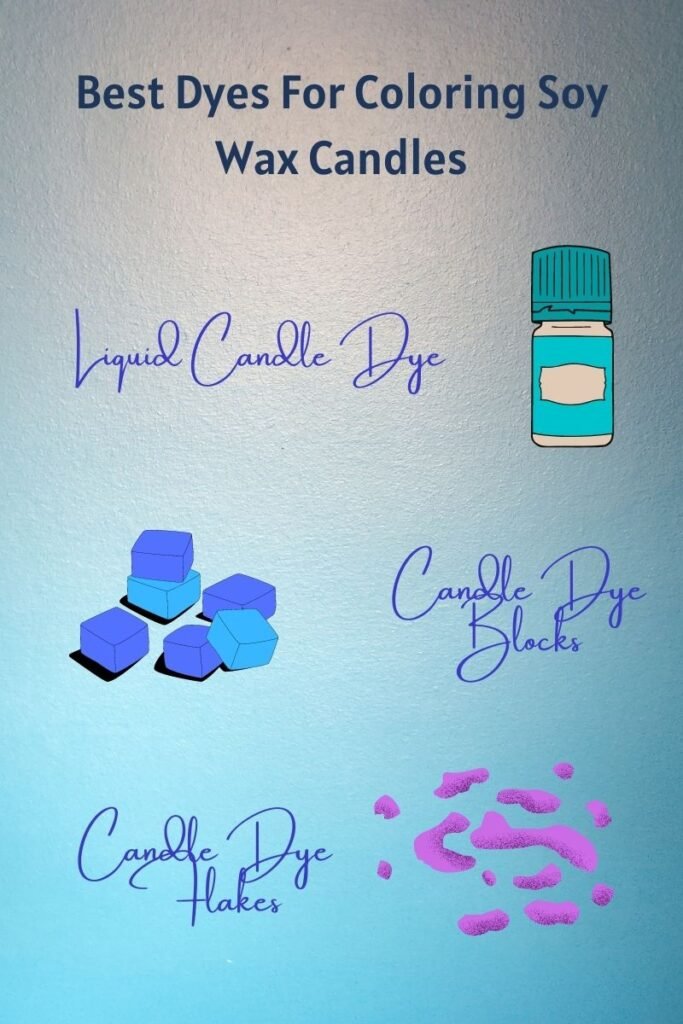
Candle dye in the form of liquid dye is formulated specifically for coloring candles. Candle dye is a great and safe way for coloring wax into different shades.
Conventionally, candle dyes are available in three distinct forms: liquid, flakes, and block. These are highly concentrated dyes. We’ll start with liquid dyes for their relative ease of use.
Liquid dye is generally packaged and sold in small bottles. All you have to do is add a few drops to melted wax, stir it, and you get a beautiful and uniform color.
Liquid candle dye comes with many advantages and makes your candle-making a great experience:
- Liquid candle dye and soy wax blend well together.
- Liquid candle dye is less prone to leaving dye particles in wax at the bottom of the jar.
- It does not clog the wick.
- The scent throw is intact. Liquid dye does not alter the fragrance.
- You can blend different colors to get the desired shade.
Liquid candle dye is a great option to color vegetable waxes (soy wax and palm wax) and paraffin wax. You need to use relatively more coloring if you are making soy wax candles. These dyes are best suited for pastel colors. Try other dying options like dye blocks if you want deeper hues.
The liquid candle dye is prone to stain your hands and surface. Therefore, cover the surface and wear gloves.
Recommended Liquid Dye: Roizefar Highly Concentrated Liquid Candle Color Dye
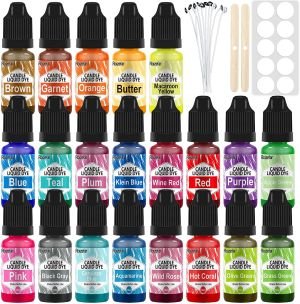
Roizefar Liquid Candle Color Dye
21 bottles for colors
Includes wicks, wick holders, and wick stickers
This liquid candle dye is available in 21 different shades and its packaging is perfect for experimenting and trying. The set includes two wick holders, ten wicks, and ten wick stickers. Each small bottle contains 10ml/0.35oz of candle wax dye.
As you add Roizefar Highly Concentrated Liquid Candle Color Dye to melted wax, keep stirring it and check the intensity of color. Add a couple more drops of the dye if you want a deeper hue.
The candle dye blends well with both organic and inorganic wax. Be it soy wax, beeswax, palm wax, or paraffin. If you make your homemade soaps then you can try it as a soap colorant too. It is non-toxic, odorless, and safe on the skin.
2. Using Dye Blocks For Soy Wax
Dye blocks are quite similar to liquid dyes or dye flakes but differ in concentration. The colorful blocks come in many different bright shades. Blocks are the most concentrated dye form of the three conventional options (flakes, liquid, or dye blocks).
They are quite popular and have a few advantages over other options.
- Dye blocks are the best option when it comes to coloring a large quantity of candle wax. One block can dye 20 pounds of wax.
- These blocks are suitable for getting deeper colors and darker shades.
- Dye blocks can be broken into smaller parts for use with smaller quantities of wax or lighter shades.
- You can blend more than two blocks to get the desired color.
- Dye blocks don’t easily stain surfaces or hands.
- Dye blocks are the best option for coloring soy candles.
Recommended Dye Block: Hearth & Harbor 24 Candle Wax Dye Blocks
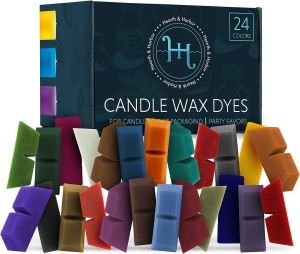
Hearth & Harbor Cadle Wax Dye Blocks
24 Candle wax dye blocks
Easy to use and doesn’t stain
These candle dye blocks from Hearth & Harbor come in 24 colors shades. Usually, 0.02-0.06 ounces of candle dye block is enough for one pound of candle wax.
Included in the box is an instruction sheet with good information on how to use the blocks for coloring wax. The dye is non-toxic and skin-friendly.
These candle dye blocks have no scent added and are completely natural. You can choose from a wide range of colors and mix two or more colors.
3. Dye Flakes Or Powdered Dyes
Because of their powdery form, dye flakes are also known as powdered dyes. Available in a wide array of colors, they are quite easy to use. When you use dye flakes, it is important to maintain the optimum mixing temperature for the wax. Add them to the wax at about 176 to 180 degrees F.
Like the candle dye blocks they too are highly concentrated and do well with large batches of wax. About 30 grams of dye flakes color around 11 pounds of wax. Dye flakes work wonders with all kinds of wax.
Recommendation: Candle Shop Store Wax Dye Flakes

Candle Shop Store Wax Dye Flakes
Wax-based candle dye flakes
Available in a variety of colors and options
Candle Shop Store Wax Dye Flakes set contains 16 individually colored dyes that blend with all kinds of wax.
These flakes are soluble, so they won’t mess with the coloring effect and do not clog the wick. The dye is highly concentrated, which means that a small amount of dye will impart bright and homogeneous coloring to wax. To put it through an example, 0.02-0.05 oz of dye will color around 1lb of wax.
There is a reference guide enclosed in the product box explaining the color mixing details. These candle flakes are vegan, non-toxic, odorless, and skin-friendly.
4. Can You Use Food Dye For Candles?
Food dye is quite a popular choice when it comes down to one of the ways to color your cuisines in your domestic kitchens and restaurants. They are concentrated, cost-effective, and come in various hues.
Food dyes are specifically designed to achieve natural coloring with standardized color intensity. Food color is available in distinct forms: Liquid, gel, paste, and powder.
These dyes are affordable, easily available, and available in a variety of hues. This may lure some of you to use it as a colorant for candles. But is food dye compatible with candle wax? Can you use food dye for candles?
Unfortunately, food dyes are not the best choice for coloring wax. Here are a few problems you could run into when using food dyes.
- Food dyes are likely to emit unpleasant odors when burnt or in contact with a flame.
- Some food dyes may contain glycerine, which is a flammable material, thus unsuited for candles.
- Liquid food dyes usually don’t blend well with wax and will sink down when mixed.
- As food dyes burn, their particles or ashes could block the wick.
- When burnt, some food dyes may release chemicals that are toxic or otherwise dangerous.
Liquid and solid food dyes especially won’t work well with candle wax. Gel-based food dyes are useful for coloring candles, but retain several of the problems listed here.
5. Mica: Can You Use It To Color Candles?
After getting to know about the different kinds of candle dyes, let’s get into knowing about mica. This naturally occurring mineral has a beautiful reflective quality like that of glitter.
Using this shimmering effect of mica as a way to add color to your candles seems interesting. However, its applications are fairly limited.
Mica powder does color your soy candles but not the way you expect. Well, it is a great option when it is about adding a shimmery or glitter effect to your candles. But to use it as a coloring agent, you have to keep the following points in mind:
- Mica powder has a high density and doesn’t blend with soy wax.
- Mica doesn’t color the candle evenly.
- Mica particles may lead to the wick clogging issue.
- Wick clogging causes the flame to extinguish on its own and leads to a small wax pool.
- Once you pour the warm wax mixed with mica into a jar, you can see mica in it. But as the wax solidifies, you only see it as the wax melts down.
This can be a bit of a disappointment. But this shouldn’t make you give up on it. Instead, you can use mica powder to add shimmer to candles in a different way. Coat the exterior of the candle with a layer of glue and using a paintbrush apply a layer of mica powder. Once it cools down, burn it. As the bright flame burns down the wax, the glitters near the surface dazzle.
In most cases, it’s a good option to sprinkle some mica on the top of the candle. It won’t burn away and will keep moving down as the wax melts. It’s a simple solution to add shimmer to the candle.
Recommendation: Cheapart 24 Colors Mica Powder Set

Cheapart 24 Colors Mica Powder Set
Includes 24 colors of mica powder
Excellent shimmer and easy to use
Cheapart 24 Colors Mica Powder Set offers 24 beautiful colors. The powder is highly pigmented and rust-proof.
The lid has a dual opening meant for pouring and sprinkling. This gives the exact powder you want to add to wax.
The mica powder adds a shimmery touch to your candles. The bottles come full to the top. Each of them is packed with a piece of plastic wrap on the top to prevent any breakage during shipping. The range of colors is diverse from pastel to darker colors.
6. Is It A Good Idea To Use Soap Dye For Candles?
Have you been thinking of using soap dye for candles? Is it worth it? Well, if you ask me then in a word, no. It’s not worth putting in your time, effort, and resources.
Using soap dyes for candles doesn’t work. Candle wax and soap dye never blend. Conventional soap dyes are water-based and the wax is oil-based. Oil floats on water, which means the dye and wax can’t mix well.
Using soap dyes for soy wax will likely result in poor and uneven coloring. Additionally, soap dyes may contain glycerine. This is a flammable material that doesn’t quite work well with a candle’s flame!
Soap dyes are manufactured for a specific purpose, which is for dying a soap. There are much better options available in the market that are meant specifically for dyeing candles.
Although, keep in mind, the market is vast. There are some dyes which are available for coloring soaps and candles. However, conventional soap dye is not a good choice for coloring soy candles.
7. Pigments: Do They Blend Well With Soy Candle Wax?
Pigments and dyes are colorants that impart color to your everyday stuff like plastic or paper. Some people often consider the two to be the same but they are quite different. Pigments are synthetic and insoluble products in the form of water or oil.
By contrast, dyes are soluble colorants. It is all about differences in terms of their solubility. Since pigments contain small particles and don’t dissolve in wax, they hamper the life of the candle as their particles clog the wick. This leads to the self-extinguishing of your candle.
8. Using Crayons To Color Soy Candles Isn’t A Good Idea
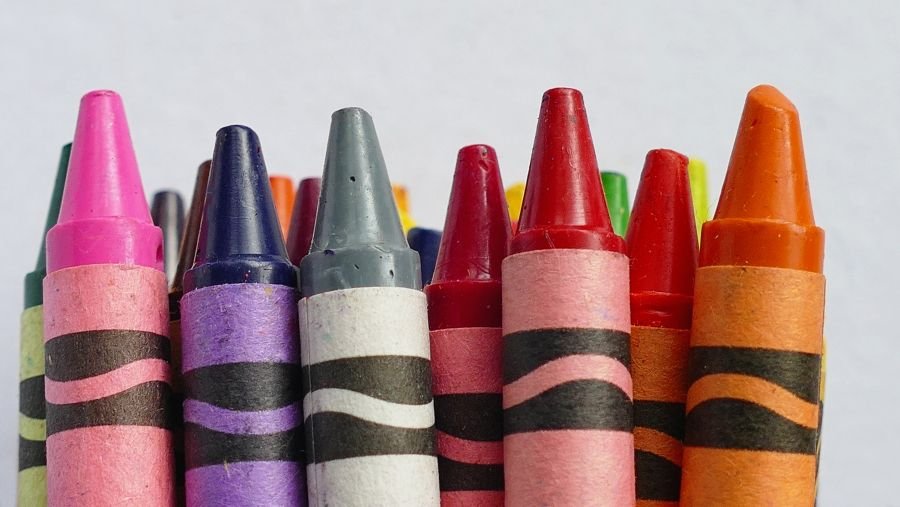
Crayons are one of the easy-to-find options that are often thought of as a colorant for candles. After all, we’ve all enjoyed the distinct colors of crayons and the aesthetic effect would look good on candles. Besides, the waxy crayon would work with soy wax candles too, right?
Imagination aside, crayons are not a good option for coloring soy wax candles.
Did you know that your colorful crayons happen to contain pigments? And as we know, pigments aren’t much use for coloring candles.
Many novice candlemakers hold the opinion that using crayons as a colorant is a great idea since both are made of wax. You get them in vibrant colors and readily available. However, the results are not ideal.
The two main components that go into making crayons are pigments and paraffin wax. As we already know, pigments are not a good option for coloring candles. Besides, there area few more problems when using crayons to color candle wax:
- The wax components in crayons are different from candle wax. Crayons are not meant to be burnt.
- Burning crayons or crayon wax may result in unpleasant smells, making them unfit for candles.
- As the wax melts and gets carried through the wick to the flame, the pigments will clog the wick.
- Crayon chunks are quite dense and settle at the bottom of the jar. The pigment floats down as it doesn’t mix with the wax.
- They may contain pigments and oxides besides paraffin. These particles lead to self-extinguishing of the wick and result in a small wax pool.
9. Color Your Soy Candles With Natural Dyes
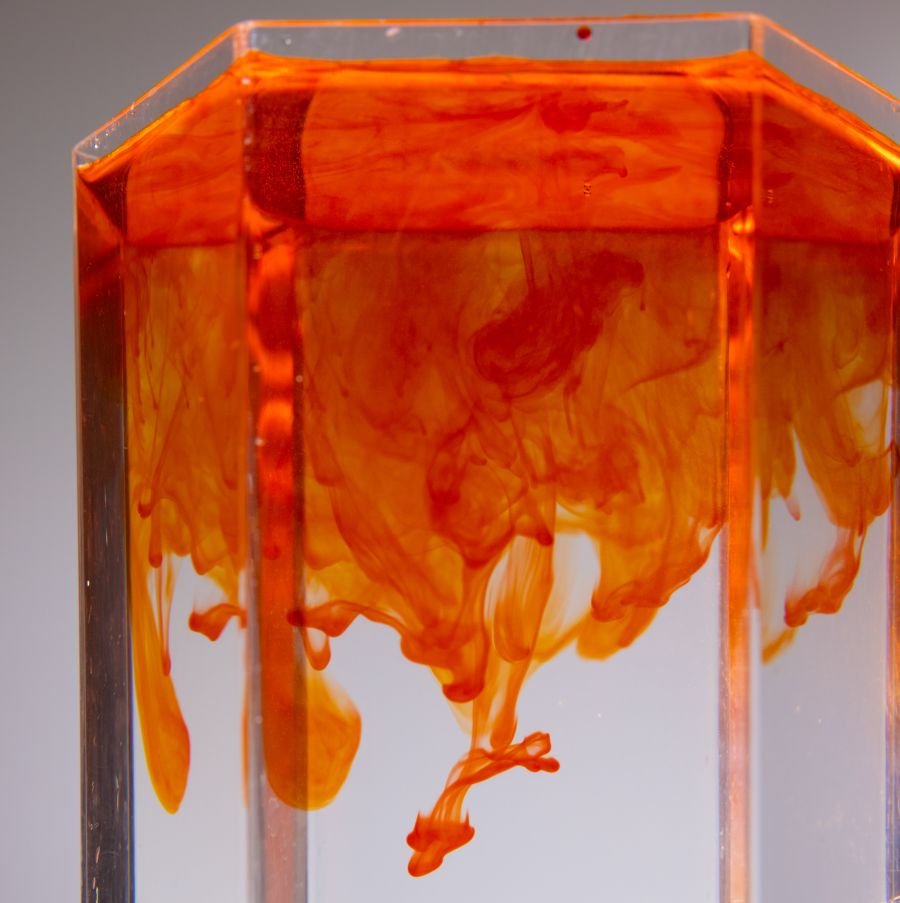
Anything natural is irreplaceable. Its essence and overall built-up are pleasing to the soul and mind. And if you use natural candles like soy wax or beeswax, you will understand what I intend to say.
Consider natural dyes as a way to color soy candles.
What Are Natural Dyes?
Natural dyes are organic pigments that are extracted from natural sources. They are primarily of plant origin and extracted from their various parts like flowers, roots, wood, leaves, and nuts. Parts of a few fruits and herbs are also wonderful forms of natural dyes.
Natural dyes are usually free from harmful chemicals. The popularity of natural dyes is a response to concerns about synthetic dyes and associated health hazards.
Natural dyes are environmentally friendly. They are renewable resources.
You have tons of options when it comes to organic ingredients that are used to dye your soy candles. Natural wax like soy or beeswax when colored naturally is like a match made in heaven. Listed here are a few such ingredients that can be used to get the desired colors:
- Red and pink: Fresh beets or powdered beetroot, pomegranates, red and pink rose petals, avocado pits, and alkanet.
- Orange: Carrots, turmeric, butternut seeds, or husk
- Yellow: Marigolds, sunflower petals, paprika, celery leaves, onion skins
- Green: Spinach, mint leaves, lilacs, artichokes, spirulina, and chlorophyll of plants.
- Indigo: Purple cabbage, blueberries, blackberries, woad, black beans
- Reddish-brown and dark brown: Henna powder, tea leaves, and coffee beans.
Extracting And Using Natural Dyes
The process of extracting natural colors is a lot simpler than you might think. You can do it all by yourself at home. Your kitchen has all the necessary items required to make natural dyes.
Assemble the following items before you start with the process: Organic material( flowers, fruits, or vegetables), a knife, pot, water, sieve, air-tight container, and heating plate.
Let’s have a look at the primer to naturally extract color from the organic material:
- Collect your organic material when they are at the peak of their color.
- Chop them into small pieces and put them into a pot.
- Measure the amount of plant material and add twice the water.
- Bring the mixture to a boil and then simmer it, stirring occasionally for at least an hour.
- Strain out the plant material and set the liquid color aside.
- Let it cool down and next store it in an air-tight container in a dark place, away from sunlight.
- Mix it with your melted candle wax whenever you think of candle making.
Alternatively, you can try another method too. Put the dying ingredient, cut into small pieces into the coffee filter and tie it with string. Now here comes the time-consuming part.
Submerge the dye bag into the pot containing melted wax. Steep it for a few hours. Pastel colors will take less time while darker shades will need you to be more patient.
These are two of the popular ways to color your candles naturally. However, you may come across more methods and choose the one you prefer.
So far we explored different ways to color candles, which are quite popular amongst candle lovers. And if we compare and contrast the different methods to color candles, then liquid candle dye, candle blocks, and flakes supersede all the other alternatives. They are specifically made for coloring candles. They have an edge over the other alternatives that we explored so far.
They are safe, readily available, mess-free, and give a long-lasting even shade to your soy candles. Any one of them is the best way to color soy candles. And now let’s see how to color your soy candles with them.
When To Add Color To Soy Wax And How To Go About The Process
The range of colors that can be incorporated into soy wax is boundless. But to get the right color, you need to know the right temperature at which to add the color. Mixing candle dye with soy wax won’t give you the perfect results if you do not pay heed to the optimum temperature conditions.
So when to add color to soy wax? You should add dye to the melted soy wax at its hottest temperature to ensure that all the dye melts into the wax, without leaving any clumps. The ideal temperature is 180 to 185 degrees Fahrenheit.
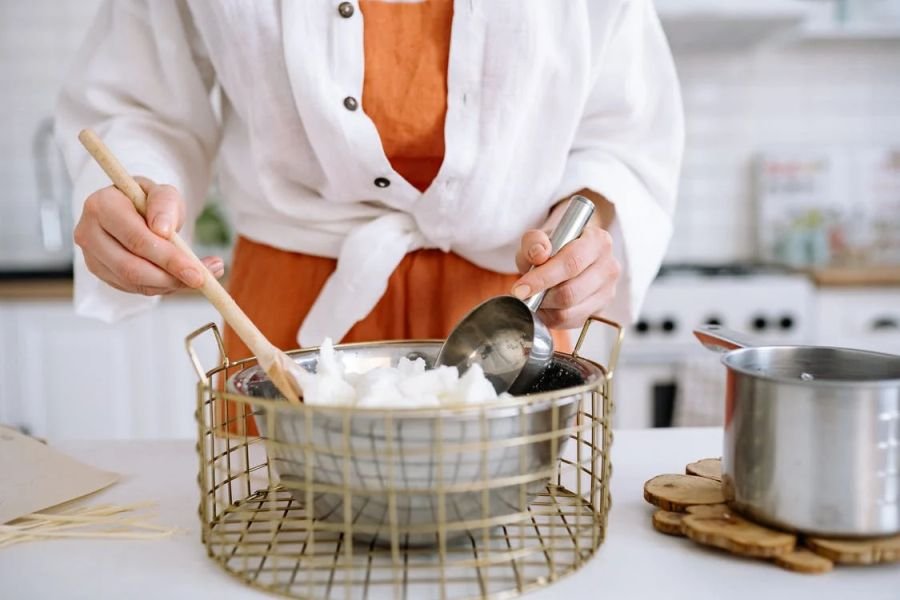
This ensures that candle dye has a uniform dispersion throughout the soy wax. Additionally, keep stirring the mixture for a while, while the heating plate is turned off.
Be careful not to heat the soy wax beyond 185 degrees Fahrenheit. If the temperature is way too high. Soy wax will become too soft and clump together. And when you add candle dye in this state, the dye will not blend with wax. The whole mixture might even fall apart once cooled.
At What Temperature Should You Pour Colored Soy Wax?
You may wonder that once the dye has blended with the soy wax, what to wait for? Just pour it into the jar! It is here that you may end up ruining all of your efforts in coloring the soy wax if you do not pay heed to the right temperature to pour it out.
After you’ve added the dye to the highest temperature of 185 degrees Fahrenheit, you cannot pour the wax and dye at once. You have to let it cool. But do not let it cool to the temperature that it hardens. The ideal pouring temperature is around 120 to 165 degrees Fahrenheit.
This step is crucial to prevent cracking and frosting of the candle. Pouring at the right temperature also saves the glass container from cracking and leakage of wax.
Layering: Mix Your liquid Dye To Create Layers Of Wax
Colors are fun to work with and your creativity makes the options limitless. It’s fun and thrilling. You just have to keep a few steps in mind and you get your mesmerizing candle.
When layering your candles, always let the wax cool completely before adding the next layer. It should be cold and fully opaque. And then pour the next colored layer. Do remember, to pour the layers at a cooler temperature. Somewhere around 140 degrees Fahrenheit is a good choice. It prevents bleeding of colors.
Frequently Asked Questions
How To Dye Candle Wax With Food Coloring?
Food coloring is not a good choice for use with candles. Food dyes usually smell terrible when burnt, don’t mix well with wax, and some might even contain flammable components. Besides, there are easier options available.
However, if you must use a food dye, consider either gel-based food color or powder. Avoid liquid form as it is water-based, therefore, does not blend with the melted candle wax. Melt the wax and mix the food color when the wax reaches 170 degrees Fahrenheit. Stir it and let it cool a bit before you pour it into a jar with the wick intact.
Can You Color Soy Wax With Crayons?
While crayons are an alluring choice to color soy wax candles, they’re not the ideal option. Crayons are generally made from a mix of wax and pigments. The wax used here isn’t the same as candle (soy) wax and doesn’t mix well. Besides, the pigments don’t dissolve in wax and remain separate.
This combination usually results in splotchy or bad coloring. The pigments don’t burn and may clog the wick. Burning crayon wax isn’t ideal either.
While enterprising and experienced candle makers can blend soy wax with crayons, it is understood that this isn’t the ideal choice for making or coloring soy wax candles.
How Do You Color Soy Wax?
There are many different ways that you can pick and choose to color soy wax. Few such options available are food coloring( gel, paste, or powder), candle dyes, mica powder, pigments(crayons), and natural dyes.
All the colorants need to be added to soy wax chunks in a double boiler method. Once the mixture cools down a bit, you pour it uniformly into the jar. Cut the remaining wick and leave it overnight. Burn it the next day.
Personalize Your Soy Candle With Vibrant Candle Dyes!
When picking the best way to color soy candles, remember it’s not just about the color but you are adding something to a naked flame. It has to stand clear on all safety parameters too.
Candle dyes, especially dye blocks and liquid dyes are the most suitable way to color soy candles. However, there are a few other interesting options available, including natural dyes that could add another dimension to the soy candle.
The process can occasionally test your patience, but the results are beautiful and well worth the effort.

